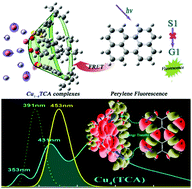Formation of Cu3,4(TCA), making the TCA complex a highly selective probe for Cu2+ detection: a TDDFT study
Abstract
Previous experimental research on thia[4]calixarene (TCA) derivatives indicated that there were, at most, two Cu2+ anions that could coordinate to one TCA molecule, and that neither Cu3(TCA) nor Cu4(TCA) complexes could form in solution. However, we studied a new type of self-assembled molecule using an ON–OFF fluorescence probe for Cu2+ ion detection, made up of tert-butylthiacalix[4]arene, micelle and fluorescence group, by the DFT/TDDFT method. The signal response mechanism was attributed to fluorescence resonance energy transfer (FRET). Based on four basic triggering conditions for the FRET process, the electronic structure, excited states and spectral properties of TCA and TCA–metallic complexes, M1–4(TCA)(M![[double bond, length as m-dash]](https://www.rsc.org/images/entities/char_e001.gif) Cu, Ni), were analyzed considering the effect on pH value. For all the metallic complexes studied, only Cu4 (TCA) was shown to fulfill all four basic conditions for triggering the fluorescence quenching signal response of the FRET mechanism. The Cu3,4(TCA) complexes were inferred to coexist with Cu(TCA) and Cu2(TCA), and would be in too low a proportion in solution to be found by some of the existing experiments.
Cu, Ni), were analyzed considering the effect on pH value. For all the metallic complexes studied, only Cu4 (TCA) was shown to fulfill all four basic conditions for triggering the fluorescence quenching signal response of the FRET mechanism. The Cu3,4(TCA) complexes were inferred to coexist with Cu(TCA) and Cu2(TCA), and would be in too low a proportion in solution to be found by some of the existing experiments.



 Please wait while we load your content...
Please wait while we load your content...